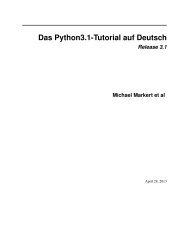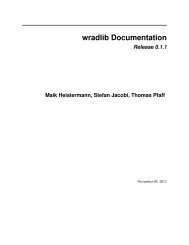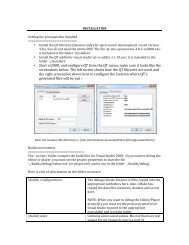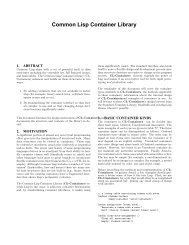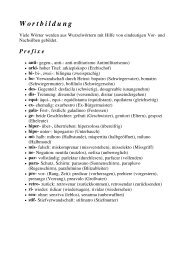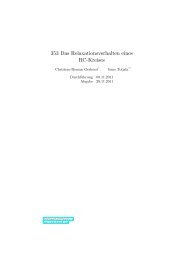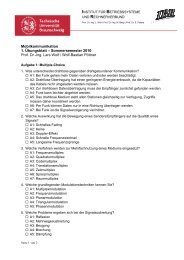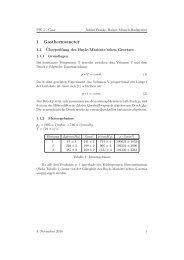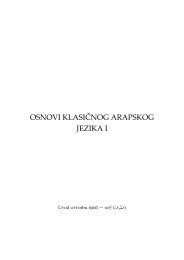P-Technique Demonstrated in Determining ... - Bitbucket
P-Technique Demonstrated in Determining ... - Bitbucket
P-Technique Demonstrated in Determining ... - Bitbucket
Create successful ePaper yourself
Turn your PDF publications into a flip-book with our unique Google optimized e-Paper software.
RAYMOND B. CATTELL, A. K. S. CATTELL, AND R. M. RHYMER 279<br />
Factor 1. "A'" Cyclothymia vs SchizothyCnia loads:<br />
A+ A--<br />
Cooperative, easy-go<strong>in</strong>g ................ vs Obstructive ............................................ 60<br />
Friendly, <strong>in</strong>terested <strong>in</strong> people ...... vs Withdrawn, shy ................................... 40<br />
Daydream<strong>in</strong>g (self-rated) ............ vs .................................................................. 50<br />
Vigorous ............................................ vs Languid ................................................. 26<br />
Jumpy, easily embarrassed ............ vs Poised ..................................................... 25<br />
That this is the more simple cyclo-schizo pattern of the orig<strong>in</strong>al<br />
A is shown by the emphasis on obstructiveness--<strong>in</strong>deed the variables<br />
orig<strong>in</strong>ally chosen as straight representatives of A and H have come out<br />
as the highest load<strong>in</strong>gs respectively <strong>in</strong> these factors. This factor seems<br />
to be the more general, generic one by the fact that there is little <strong>in</strong> it<br />
besides the load<strong>in</strong>gs <strong>in</strong> the two orig<strong>in</strong>al cyclo-schizo variables. That<br />
daydream<strong>in</strong>g should appear on the cyclothyme side is a little startl<strong>in</strong>g,<br />
but the subject expla<strong>in</strong>ed that she rated herself not on any <strong>in</strong>tensive<br />
compensatory phantasy life but on pleasant, relaxed mus<strong>in</strong>g<br />
which depended most on whether or not she was <strong>in</strong> a hurry! (Note<br />
also its appearance <strong>in</strong> Surgency, below). In this connection one notes<br />
that "optimistic" appears <strong>in</strong> the orig<strong>in</strong>al cyclothyme factor patterns.<br />
Factor 3. "G" Positive Character Integration vs Immature, Dependent<br />
Character loads:<br />
G+<br />
Persever<strong>in</strong>g, strong-willed ............ vs<br />
Self-sufficient .................................... vs<br />
Shy, cautious .................................... vs<br />
Steady, stable .................................... vs<br />
G--<br />
Quitt<strong>in</strong>g, fickle ................................... 44<br />
Not self-sufficient ............................... 42<br />
Friendly, <strong>in</strong>terested <strong>in</strong> people ......... 40<br />
Emotional ............................................. 37<br />
That this second factor <strong>in</strong> the general realm of character is G<br />
rather than C is evidenced by persistence and self-sufficiency be<strong>in</strong>g<br />
high, while emotional stability, still <strong>in</strong> the pattern (as <strong>in</strong> C), is low.<br />
At first, it is a little surpris<strong>in</strong>g to f<strong>in</strong>d shyness and caution here, but<br />
<strong>in</strong> the orig<strong>in</strong>al R-technique factor (7) "reserve" and "self-consciousness"<br />
appear at about this same level.<br />
Factor 2. "F" Surgency vs Desurgency (or Hysteria-Dysthy~<br />
mia ) loads:<br />
F+ F--<br />
Physiological ease ............................ vs Emergency alertness (Test factor 2) .53<br />
Cheerful, talkative .......................... vs Depressed, worried ............................. 37<br />
Cooperative ........................................ vs Obstructive ........................................... 34<br />
Daydream<strong>in</strong>g .................................... vs ................................................................... 32<br />
Submissive .......................................... vs Dom<strong>in</strong>ant, self-confident ................... 30<br />
Steady emotionally .......................... vs Emotional ............................................. 30<br />
Not self-sufficient (Sociable) ........ vs Self-sufficient ....................................... 27




